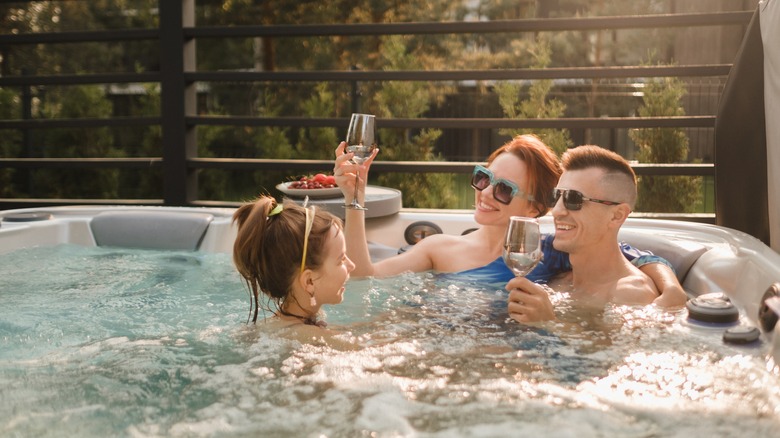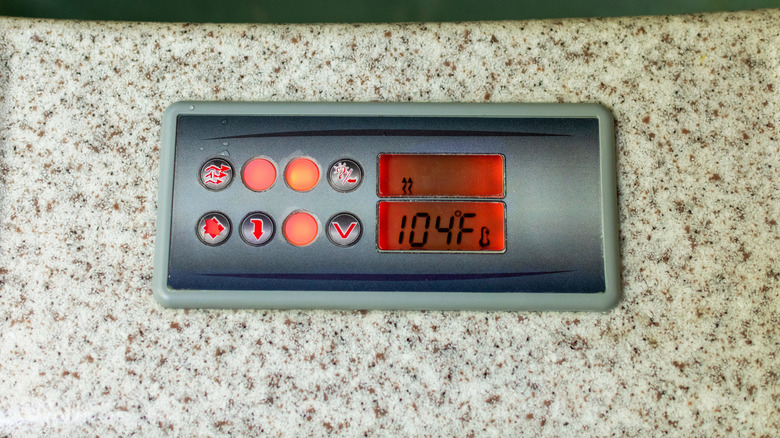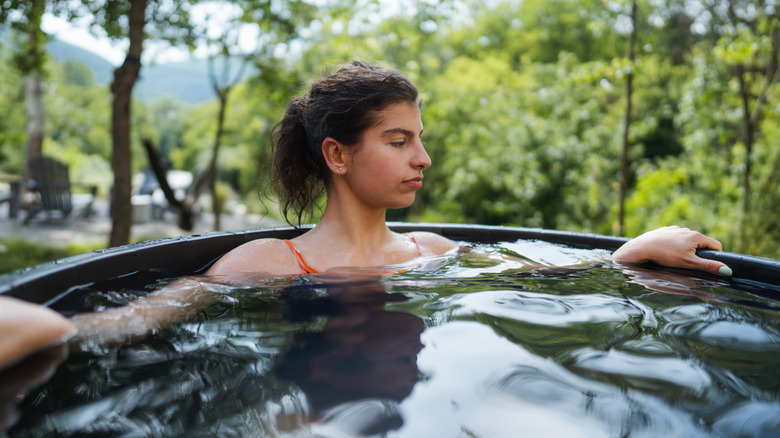An Ingenious Way To Repurpose Your Hot Tub To Stay Cool In Summer Months
If you have a hot tub in your yard, you may sigh in frustration as it sits idle in the summer months, all while the mercury climbs and a cold water dip becomes more and more enticing. Some of the best hot tubs on the market come with a cooling function. If you've got one, then you're set — simply switch between the heating and cooling modes and your tub turns into a cold plunge pool. But if your hot tub is only equipped with a heater, don't despair. Since the tub is insulated — and the insulation prevents heat transfer both out and in — you can repurpose it to stay cool with a couple of different techniques.
Even without a cooling function, you can manipulate the hot tub's controls to bring the water temperature down to swimming pool levels. This technique may require additional water added to the tub along with some protective measures to keep the water cold on a hot day. But to make the tub's water truly ice-cold, you may have to invest in a compatible cooling system and hook it up professionally to the hot tub. Find out how both methods reorient your hot tub for summer use below!
How to cool the water in your hot tub
If your hot tub doesn't come with an integral cooling function, you can just lower the water temperature enough to feel cool during the hot summer months. To "summerize" your hot tub after the winter season, start by turning the heat setting down. How low you go depends on where you live. In cooler climates, set it around 80 degrees Fahrenheit to get refreshing, yet comfortable water. On the other hand, you can shut the thermostat off altogether if you're in the scorching south.
A low heat setting is often not enough to cool the hot tub water quickly. That's where you can take advantage of the tub's jets. The jets will circulate the water inside the tub and inject it with air, which helps bring the water temperatures down. Of course, if you need to cool the water quickly, tweaking the heat settings and running the jets may not get the job done fast enough. In this case, you can partially drain water out of the tub and refill it from your water hose. That said, hosing the water over the tub's side may cause airlocks in the tub's plumbing, so attach the hose to the correct filling pipe per the manufacturer's instructions. Now, even with the jets on and cold water added, the tub water may gain temperature thanks to sun exposure. That's why it's a wise idea to protect the tub from the sun with an umbrella or other shading device.
When to invest in a cooling system for the hot tub
Even without a dedicated cooling system installed, lowering the hot tub water temperature affords an easy way to go for a refreshing swim during the year's hottest months. But this method won't suffice if you want to turn the tub into a DIY cold plunge pool for therapeutic use. Some research has hinted that cold bath therapy may reduce autoimmune inflammation and regulate stress. However, water temperatures must be between 45 and 60 degrees Fahrenheit for the therapeutic effects to occur. Making the water this cold is impossible without a cooling system — not with summer daytime highs of 80 degrees or more keeping the air temperature hot.
Fortunately, you can pipe in a chiller like this one from Desert Hot Tubs to cool the water in the repurposed hot tub sufficiently for cold plunge use. These chillers resemble air conditioners and work the same way, except they pass water over their coils instead of air. To install one of these units, you'll need a pool contractor to change the plumbing in the tub such that its pump runs when the integral heater isn't on. This way, the pump can circulate the warm tub water through the chiller to decrease its temperature. And when the outdoor temperatures dip after sunset, you can revert back to the tub's heating mode and make the water comfortably warm.



